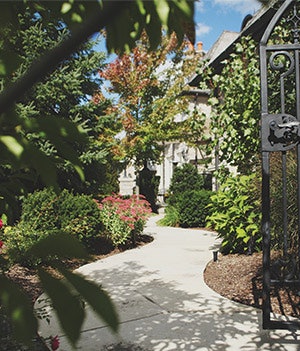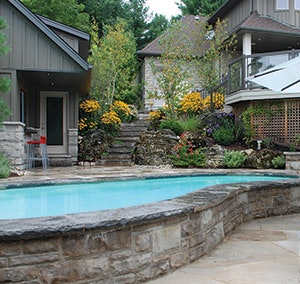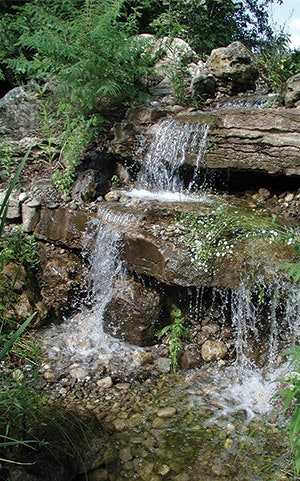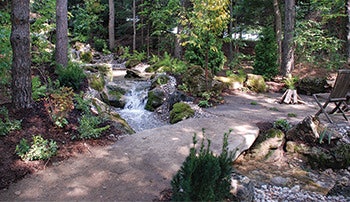Have you ever wondered why some landscapes create an emotional response while others don't, even though they appear well designed and properly built? I believe the answer relates largely to the way the elements within a property relate to each other and in turn impact the experiences of those who spend time there.

As designers, we have the opportunity to create an element of intrigue, to create places in people's homes that say, "This is where your heart wants to go."
In our work at Tumber & Associates, we've learned to clear that bar by focusing not so much on the individual elements in the design — which are certainly important — but far more significantly on how they work together. So often, customers start out focusing on the tile or deck material, but those are short strokes that really should flow from the way the larger puzzle pieces are shaped and arranged.
It's a process that is both highly subjective, yet disciplined, and begins the moment I visit a property. Whether large or small, simple or complex, it all begins by first understanding that when you move through an environment, both visually and with your feet, you should feel the excitement of being on a journey.
A SENSE OF PLACE

The first step in plotting those journeys is to identify the most obvious "presentations," meaning primary focal points and views. That could be any number of things: a view from the back of the house, the first sight when driving onto the property or what you see when you look back at the house from a property line.
Ask yourself: What is the vantage point? What does it present?
In the simplest terms, the idea is to identify the things you like and those you don't. You look for the features and characteristics that have the potential for something beautiful. That might be a distant hillside vista or a body of water. It could be an intimate view of a stand of trees or a place on the property that receives the most sunlight in the morning.
Then, at the same time, I look for things I consider to be red flags, or the lines of sight we want to avoid. Maybe it's a view of a neighbor's front door, the way the parking space presents itself or a view of unattractive structures adjacent to the property.
These initial impressions are extremely important because as designers, we have the advantage of objectivity — at least initially. In most cases, our customers have lived in their homes long enough that they've seen the eyesore so many times, they're not even aware it's there.
It's also critical to acknowledge those red flags and take mental notes, because after seeing them just a few times, you're likely to look right past them as well. In that sense, if you don't actively make those determinations very early on, you can lose your objective advantage over the customer.
That all sounds pretty basic, but it's really where the design starts: combining what the clients believe they want with our own ideas about what will work on the site. From there, we embark on a shared journey of trying to create areas of interest that relate not only to each other, but the interior spaces as well.
It's a process similar to the way a professional photographer frames a view. Some things are in the shot, while others are outside the boundaries of the image.
PLACE TO PLACE

Once you identify those key viewpoints, the next step is to make sure guests can't walk outside and see everything all at once. There have to be areas of interest and excitement that are secluded on some level.
Pools, spas and other water features are almost always points of tremendous visual interest, as well as active destinations. As such, we always try to maximize the impact of those features by not exposing everything in the landscape at first sight.
This is why we modulate most landscape features, aquatic or otherwise, with sweeping lines and soft contours, whether it's a driveway or a path through the garden or a deck around the pool. We leave crumbs, so to speak, so someone in the landscape can catch a glimpse of something in the distance, but has to walk over to see more.
Then, once they get over to that area, they're in a different zone, maybe even a slightly different mindset. If we've done our job, that zone rewards the journey, whether it's a gazebo, a reflecting pond, a fountain, hot tub or a part or all of the swimming pool. As you arrive, you discover a place to sit, take in the view, listen to the sound of moving water, eat or drink, warm by a fire, cool off in the shade or go for a swim. And maybe while you're digesting that experience, you notice that off to one side is a pathway that leads to yet another zone, another destination.
It's all about creating curiosity, subconsciously pushing people to explore.
When we're developing a project, I'm always trying to lead my clients through these various spaces by utilizing foreground, intermediate and background views, which all work together to create a sense of depth, scale and dimension. Within those layers you make decisions not only about what your putting into the design, but the size of it, the relative relationships to one another and all the other visual elements that come into play, such as texture and color.
In essence, you create a storybook where everything is intriguing enough that the "reader" gets hooked on the story and can't put it down. When landscapes are emotionally exciting in that type of narrative context, they appear fuller and even larger, because in a sense, they become more by the way we arrange the elements within them. It's a multi-dimensional process in more ways that one.
NATURAL EMBRACES

Of course, every project and set of clients are different, as are contractors. We all have preferred styles and ways of approaching the work. Some of us lean toward more architectural forms, while others tend toward more naturalistic designs, and many do both.
In our company's case, we've always focused on naturalistic forms as well as architectural elements that fit comfortably with nature. I think about places like a sweeping beach lined with palm trees, peaks of alpine mountains, a beautiful sunset or a harvest moon. Those are the sights that move us, far more so than the most beautiful city. The fact is, humans are wired to respond emotionally to natural settings, and as designers we have an opportunity to make use of that psychological characteristic.
It's very seldom I meet someone who is indifferent to a place that reveals some type of natural beauty. By contrast, I've certainly seen unemotional reactions to purely architectural designs where everything's on a grid and visible all at once, even when those designs are full of different elements.
When you work turns toward more natural shapes, textures, colors and materials, you're strengthening that sense of discovery, the power of moving from one place to another, because the natural world always presents a journey of some kind.
This is why most of our pools, for example, are multi-radius (or kidney-shaped, as some people still call them). To me, those undulating, curvilinear edges can give you that feeling of movement, because as you walk around the pool, the view shifts. I know rectilinear pools are very popular, and many fantastic designers go in that direction. But in terms of organizing space and managing views, rectangles for the most part look the same from every angle.
In addition, when you're working with curved edges, the way the water interfaces with surrounding greenery appears comfortable, as if it's settled into the landscape. Even in a small yard, a radius pool embraced by stands of greenery inspires visual movement and, again, mystery.
In another aquatic context, when working with streams, the modulated curvature coupled with stands of plant life enable you to conceal the water's sources. That might seem a small thing, but if there's anything that disrupts the impression that a stream is natural it's being able to see where the water is coming from. By contrast, if the stream winds out of view behind some rocks or trees, it doesn't matter that you know intellectually that it's man-made because the emotional need is satisfied.
IMPORTANCE OF INTEGRATION
When you work to integrate elements within the landscape, you're essentially putting yourself in the clients' shoes for their benefit. Oftentimes, I take that to a literal level by sharing designs in a narrative form, whether it's on a computer screen, a rendering or a walk through the site.
I often start with what you see when you approach the front of the house, which is something many pool builders and designers often ignore because their work is usually focused in the backyard. But that's where set the tone for the experiences that follow inside the home and when you step out into the back.
The use of trees to frame views, curved paths, berms and slopes, walls, fences and water features can be used to establish that feeling of discovery. And in many situations, it's not an overly elaborate set of elements, but the shapes, proportions and that all-important idea of an unfolding story.
Those fundamental principles can be used on the most modest projects or the most elaborate. Simply varying the height of plants with lower profiles in the near views, transitioning to taller species farther back in the planted areas, will create depth and intrigue. You can be standing 15 feet away from a roadway, but feel like you're in a completely different world simply by the way you arrange the layering of views.
All of this is, I believe, the great potential that exists in aquatic and landscape design; it's not just the elements you and the client choose, whether it's a massive pool or a small spa or a trickling fountain. It's how the story unfolds before your eyes that make the biggest differences.
Comments or thoughts on this article? Please e-mail [email protected].











































